Anyway, before heading off to the Island State we spent a weekend (March 15 and 16, 2014, to be precise) with our friends Cho Gek Tan and Paul Pui in Melbourne. This gave Eileen a chance to catch up, and gave me the opportunity to introduce Ryan to animals and other things Australian before heading off into the Tasmanian wilderness (well, Hobart anyway). So here is Ryan on Saturday, looking down at the distant Melbourne cityscape from the heights of the Dandenong Range, where Paul and Cho Gek had taken us for an afternoon drive on our first day.
Our vantage point was the lookout park at SkyHigh, where (among other things) Ryan and I (with Paul in the background) admired the Australiana Tree. This is a Messmate (Eucalyptus obliqua) that sculptor Leigh Conkie in chainsawed (in 2006, after the tree was almost killed by a lightning strike) into a totemic representation of the animals and people of the Dreamtime.
As for real animals - well, it was a drizzly afternoon, and we had to be content with a quite tame Australian Raven (Corvus coronoides).
To do better than that in a short space of time, the best place near Melbourne is the Healesville Sanctuary - less a sanctuary than a zoo, but a zoo devoted exclusively to Australian wildlife. That was our destination (well, at least Ryan's and mine) on Sunday.
You need hardly step in to the zoo gates to see the most beloved of Australia's marsupials, the Koala (Phascolarctos cinereus). For those who don't know, Koalas look cuddly but are, by all accounts, rather grumpy creatures, capable of delivering a substantial bite. The lower photo shows one of their most distinctive features, a peculiar, opposable "double thumb" formed by the true thumb and index finger. The result allows Koalas to seize eucalyptus limbs in a particularly firm grip.
With, us on the trip (indeed, doing the driving) was my young pal Alicia Eng, daughter of our friend Mui Ling. Alicia and her mother had gone camping with us two years earlier, at Lamington National Park in Queensland, and it was great fun to get together again. Here, Alicia and Ryan are looking forrad with some anticipation to the Healesville bird show.
The show, not unlike bird shows I had seen at other zoos, featured flight-trained birds, including a Sulphur-crested Cockatoo (Cacatua galerita)....
...and a very nice Barking Owl (Ninox connivens).
The zoo's Wedge-tailed Eagle (Aquila audax), Australia's largest bird of prey, was of course a featured attraction. This bird, named Jess (presumably for the leather straps, or jesses, tied to his feet) is the oldest animal at Healesville; he turned 44 on September 16, 2015.
However, for me the highlight of the show was a very nice illustration of an unusual bit of natural history. The Black-breasted Buzzard (Hamirostra melanosternon), one of Austalia's handsomest birds of prey, is something of an egg specialist. With the Egyptian Vulture (Neophron percnopterus), it is one of only two birds of prey in the world to have learned (instinctively, apparently) to smash open large eggs (ostrich eggs for the vulture, emu eggs for the buzzard) by hitting them with a rock.
Healesville illustrates this nicely by providing their buzzard with a fake emu egg and a stone, and letting the bird strut its stuff. Unfortunately my camera missed the exact moment, but it was an impressive demonstration; others have captured the bird's performance on video.
As we continued on our way through the zoo, Ryan was able to get on close terms with a Bennett's wallaby (Macropus rufogriseus), a smallish kangaroo we would soon see in the wild in Tasmania.
Another demonstration introduced Ryan to a Platypus (Ornithorhynchus anatinus) that seemed to enjoy playing with a bit of weed (and having her tummy tickled by the keeper). We would miss the platypus in the wild (not for lack of trying; during my two years in Australia [1972-74] I only saw a platypus once) but, as you shall see in later posts, we were to have much better luck with its other egg-laying cousin, the echidna.
Platypuses have presumably been in Australia since the Cretaceous at least. The Dingo (Canis lupus dingo, or, according to a recent study, Canis dingo, a species in its own right) is a much more recent arrival, the first in a long line of mammals brought to Australia by human invaders. Dingoes probably arrived in Australia sometime between 1,000 and 5,000 years ago.
Healesville is involved in captive breeding programmes for two rare alpine skinks, the Alpine She-oak Skink (Cyclodomorphus praeltus) and the Guthega Skink (Liopholis guthega).
This is a Guthega Skink, a species known from two tiny, isolated populations only. It is a high-alpine species that (unusually for a lizard) hibernates during cold winters.
I particularly enjoyed a visit to Healesville's large flight cage, where Ryan got to feed a Red-tailed Black Cockatoo (Calyptorhynchus banksii).
The aviary provided a good opportunity for close-up photos: for example, of this Bush Stone-Curlew (Burhinus grallarius).
The Common Bronzewing (Phaps chalcoptera), is one of the largely-terrestrial Australian pigeons that seem to take the place of partridges in other parts of the world. The light was just right to show off the reason it sports the name "bronzewing".
An aviary is also a good spot to get close-up, unobstructed views of a Superb Lyrebird (Menura novaehollandiae).
Another "superb", on a much smaller scale: a heavily-moulting Superb Fairy-wren (Malurus cyaneus).
Zebra Finches (Taeniopygia guttata) have become the equivalent of lab rats for many ethologists. Alicia took the lower photo, which I admit is better than mine.
Outside the aviary, I was glad to see a Pied Heron (Ardea picata), a tropical species (with very distinctive plumage) that I last saw around Darwin in 1973.
As Ryan and I were going to Tasmania, we made a point of checking out Tasmanian specialties. The Swift Parrot (Lathamus discolor), a bird that breeds only in Tasmania but winters through the Australian southeast (I saw one near Sydney in the 1970s, my only encounter with it in the wild), is in serious trouble. Its populations have dwindled disastrously, and Birdlife International now categorizes it as Critically Endangered. The main problem, oddly enough, has been the introduction of Sugar Gliders (Petaurus breviceps) into Tasmania; these little marsupials are highly efficient predators on Swift Parrot nests.
For Ryan, of course, the ultimate Tasmanian animal was the Tasmanian Devil (Sarcophilus harrisii) - another species in serious trouble, this time from Devil Facial Tumour Disease (DFTD).
These are unfortunately-named animals, but watching this one tear into a wallaby carcass does make it appear to be a creature on the ferocious side. This is a shy creature, though, and the name seems to come from its nocturnal cries.
Though Healesville is, as I said, basically a zoo, that does not mean that you cannot find wild animals there. Australian White Ibises (Threskiornis moluccus), for example, hung around the picnic tables, hoping for a handout.
Ryan was quite excited about this European Rabbit (Oryctolagus cuniculus) nibbling away at a patch of lawn; I had to explain to him that rabbits (thanks to us) have devastated great swaths of Australian habitat, and are not beloved of Australian naturalists.
A large pond on the property hosted wildlife of its own (and a nice boardwalk around it, with a railing to lean on as you watch).
Here were a few birds, including a Dusky Moorhen (Gallinula tenebrosa), the Australian replacement for the moorhens of Europe, Asia, Africa and the Americas.
More exciting to me (and, I think, to Ryan and Alicia) was an Eastern Long-necked Turtle (Chelodina longicollis), its shell heavily grown with algae. As this turtle has not made it to Tasmania, this was our only real chance of seeing one.
Our flight to Tasmania was scheduled for Monday evening. Alicia had to work, but that gave Eileen, Ryan and I the day to see the sights of Melbourne, including this oversized change purse. Downtown Melbourne is not loaded with natural history, but it does have the Sealife Melbourne Aquarium, and I certainly couldn't keep Ryan away from that.
Old Wife, Enoplosus armatus
However, I'll only show you a bit of it here: first, Ryan encountering an Old Wife (Enoplosus armatus), an Australian endemic once thought to be a sort of butterflyfish, but now considered distinctive enough to be placed in a family of its own, Enoplosidae.......and second, an Elephant Shark (Callorhynchus milii). This is not a shark but a chimaera - a distant shark relative, a member of a fascinating group of fishes I had never seen alive before, and according to a recent study, a creature with the slowest-evolving genome of any vertebrate. Its genetic makeup has, apparently, hardly changed since its ancestors diverged from sharks and rays, some 426 million years ago.






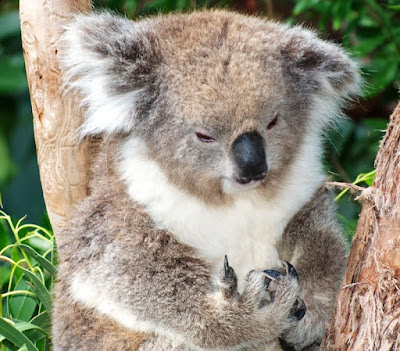















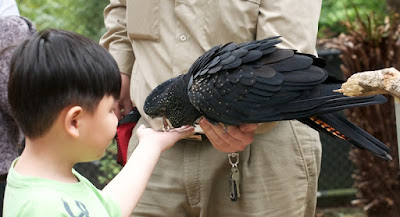




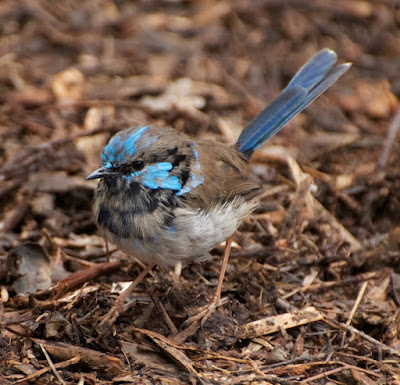




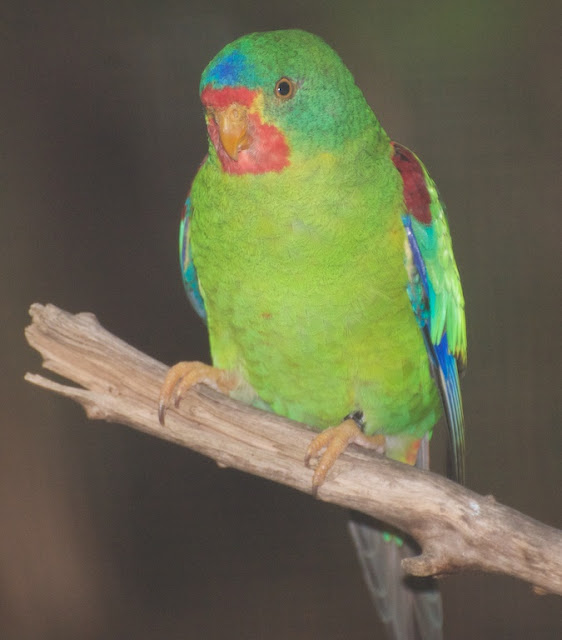




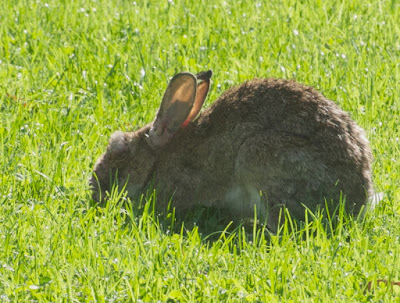



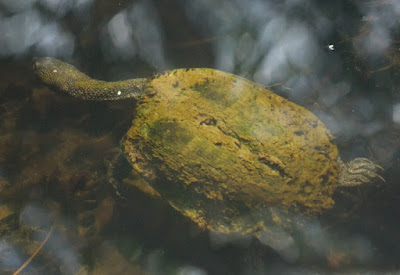


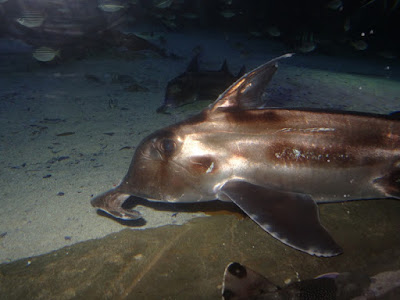
No comments:
Post a Comment